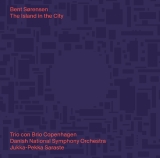Der dänische Komponist Bent Sørensen (« 1958) hat mit dem für diese Produktion erstmals aufgenommenen Stück L’isola della Città ein Tripelkonzert komponiert, das, wie jenes von Beethoven, die Besetzung Violine, Cello und Klavier benutzt. Doch im Gegensatz zu Beethoven, der darum bemüht war, dieses Trio eng ins Klanggeschehen einzubinden, stellt der Däne das Trio dem Orchester gegenüber, oder richtiger noch, er umgibt es mit dem Orchester, so dass es eine Insel mitten in der Stadt wird. Das ergibt eine abwechslungs- und kontrastreiche Komposition, in der das Trio agiert, als werde es von der Stadt verfolgt und versuche ihr zu entkommen. Und doch überrascht uns Sørensen immer wieder, wenn Insel und Stadt sich in ihrer Verfolgungsjagd sozusagen in Schönheit finden. Nun darf man nicht glauben, dass die Stadt besonders viel Lärm mache. Das Orchester spielt nie wirklich laut. Neben den schönen und ruhigen Passagen gibt es viel Hektik, aber halt ohne Lärm. Das erlaubt es dem Komponisten, wunderbare Texturen zu schaffen, die sehr suggestiv wirken in dieser spannungsvollen Interpretation des Con Brio Trios und des Nationalen Dänischen Symphonieorchesters unter Jukka-Pekka Saraste.
Von seiner Zweiten Symphonie sagt Sørensen, es sei ihm wichtig, dass man sie nicht Symphonie Nr. 2 nenne, sondern Zweite Symphonie. Die, welche ihr in der Gattung vorausging, heißt einfach Symphonie. Zweite Symphonie ist also ein Titel, keine Nummerierung.
Der Komponist beschreibt sein Werk so: « Der erste Satz beginnt mit einem Schrei. Die folgenden Teile des Satzes bilden ein einheitliches, aber komplexes Ganzes, in dem Spuren aus den kommenden Sätzen auftauchen – ständig in Wechselwirkung mit dem Schrei und seinen Echos.
Der zweite Satz ist langsam und eher melodiös. (…) Der dritte Satz ist ein Scherzo – wimmelnd, rhythmisch, mit fast körperlichen weichen und heftigen Begegnungen, wie Liebesakte zwischen den verschiedenen Schichten der Musik.
Der letzte Satz ist ein Abschiedslied – ein Lebewohl. Ein musikalisches Schiff nähert sich, um dann wieder zu verschwinden. (…) und in diesem Satz wurde ich auch von der Tatsache beeinflusst, dass meine Mutter während der Komposition dieses Stücks verstorben ist. Vielleicht ist das mein Abschied, den ich in Musik schreibe. »
Auch in dieser Symphonie fallen die flirrenden Töne und irgendwie verwischten Klangtexturen auf, die Sørensens Klangsprache charakterisieren. Das Laute wird ebenfalls weitgehend vermieden, und die Musik gleitet mal mit mehr, mal mit weniger Bewegung dahin wie ein Schiff auf dem Wasser, mit vielen schillernden Farben, ohne direktes Ziel und quasi irreal. Die Zweite Symphonie ist, wie L’isola della Città, eine Täuschung des Zuhörers, denn die Musik ist nicht die der Welt, in der wir leben, sondern eher die einer Welt, die dahinter liegt.
With L’isola della Città, recorded for the first time for this production, the Danish composer Bent Sørensen (*1958) has composed a triple concerto which, like Beethoven’s, uses the instrumentation of violin, cello and piano. But in contrast to Beethoven, who integrated this trio closely into the orchestral sound, the Dane juxtaposes the trio with the orchestra, or more correctly, surrounds it with the orchestra so that it becomes an island in the middle of the city. This results in a composition rich in variety and contrast, in which the trio acts as if it were being pursued by the city and trying to escape it. And yet Sørensen surprises us again and again when island and city find each other in beautiful moments. Now one must not think that the city makes particularly much noise. The orchestra never really plays loud. Besides the beautiful and quiet passages, there is a lot of bustle, but just without loud music. This allows the composer to create wonderful textures that are very evocative in this exciting interpretation by the Con Brio Trio and the National Danish Symphony Orchestra under Jukka-Pekka Saraste.
Of his Second Symphony, Sørensen says it was important to him that it is not called Symphony No. 2, but Second Symphony. The one that preceded it in the genre is simply called Symphony. So Second Symphony is a title, not a numbering.
The composer describes his work thus: « The first movement opens with a scream. The subsequent parts of the movement form a unified but complex whole, where traces from the coming movements turn up – constantly in interaction with the scream and its echoes. The second movement is slow and rather melodious. (…) The third movement is a scherzo – teeming, rhythmic, with almost physical soft and violent meetings, like acts of love between the different layers of music.
The last movement is a farewell song – a goodbye. A musical ship is approaching only to disappear again. (…) and in this movement I was also influenced by the fact that my mother passed away during the composition of this piece. Maybe this is my farewell that I write in music. »
Also noticeable in this symphony are the shimmering tones and somehow blurred textures that characterize Sørensen’s musical language. Loudness is again largely avoided, and the music glides along, sometimes with more, sometimes with less movement, like a ship on the water, with many glistening colors, without a direct destination and quasi-unreal. The Second Symphony, like L’isola della Città, is sort of a deception of the listener, because the music is not that of the world we live in, but rather of a world that lies beyond.
























